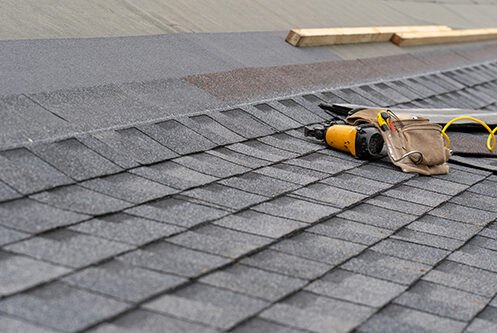Installing a new roof on your Georgia home requires a considerable financial investment. Understandably, Georgia homeowners do whatever they can to get the most out of their investment. There are several factors, including the type of roofing material used, the type of maintenance given, and weather conditions that can impact a roof’s lifespan in Georgia.
Popular Roofing Materials and Their Lifespans
Several roofing materials are common in Georgia. Each comes with its own pros and cons.
Clay Tiles
Clay tiles are a popular roofing option due to their durability and weather resistance. They can endure for 50 to 60 years, with some properly maintained clay roofs lasting over a century.
Slate
Slate, one of the oldest roofing materials, boasts exceptional longevity. Natural slate tiles can endure for over 150 years, with some centuries-old buildings retaining their original slate tile roofs. However, the heaviness of slate necessitates reinforced roofing structures. It’s essential to distinguish between natural and man-made slate, with the latter lasting between 20 and 60 years.
Metal Roofs
Metal roofs, comprising tin, aluminum, zinc, or copper, offer durability ranging from 40 years to several centuries, particularly in the case of copper. For instance, St. Mary’s Cathedral features a copper roof installed in 1280 A.D. that remains intact over 730 years later. Despite their longevity, metal roofs can be up to three times the cost of asphalt shingles.
Cedar Shingles
Treated cedar shingles can last up to 50 years when adequately maintained due to the natural oils in cedar that resist insect attacks and decay.
Fiberglass
Commonly found in commercial buildings, fiberglass roofing can endure for 50 years or more with proper maintenance. Its strength-to-weight ratio makes it efficient and offers resistance to corrosion, insects, and mold.
Asphalt Shingles
Asphalt shingles, ranging from 15 to 40 years in lifespan, are influenced by weather conditions and climate. Three-tab shingles, the most economical option, last 15 to 20 years, while dimensional or architectural shingles can endure 20 to 30 years. Premium shingles, the costliest option, can last 25 to 40 years.
Other Factors That Impact the Lifespan of Your Roof
The diversity in the lifespans of roofing materials underscores the importance of material selection. However, material alone is not the sole factor determining a roof’s longevity in Georgia.
Quality of Materials
Regardless of the type of materials you use, there will be low-quality and high-quality versions of each. Low-quality roofing materials are typically less expensive to purchase upfront. However, they require more repairs and have a lower life expectancy. So, while it requires a larger initial investment, it’s often best to choose the superior roofing material for your roof. If you have questions, our team of experienced roofing professionals at Fraser Roofing, LLC can guide you in selecting the best roofing material for your roof.
Underlayment
The underlayment is a key component of the residential roof. It helps the roof maintain its waterproof protection, even if the exterior roofing material gets damaged. This second layer of defense prevents moisture from building up and mold from growing on the wood and other materials used to build the structure of your roof. A properly installed underlayment can make the difference between a roof with a long lifecycle and one needing to be repaired or replaced after just a few short years.
Quality of Installation
Prior to choosing a roofing contractor, take the time to look at their qualifications. This includes their experience, testimonials from other customers, insurance coverage, and licensing. Working with the right installer who is detail-oriented and pays close attention to the installation process can make a difference in the lifecycle of your roof. You only want to work with an installer who recommends durable, high-quality materials and guarantees the quality of their workmanship.
The Weather
Climate is a factor that you cannot control. Climate includes everything from sun exposure to storms to precipitation. In Georgia, it is common for there to be long sunny days followed by unexpected heavy rains, windstorms, and, at times, hailstorms. Fluctuations in temperature, gale-force winds, and other weather factors can minimize the lifecycle of your roof. As a homeowner, you can help mitigate some of the effects of the climate by ensuring that any trees on your property do not rub away the roof material during high winds. Trim trees so that in the case of a heavy storm, branches do not fall on your roof, damaging it.
Color of Material
The color of your roofing material, especially in sunny climates like Georgia, can greatly affect how long your roof lasts. You should use lighter roofing materials because dark products will absorb excess heat from the sun. Overheated roofing material may experience wear and tear, and your roof might not have sufficient ventilation to combat the added heat.
The Slope of the Roof
The pitch of your roof will impact how well it drains. If your property has a flat roof or a roof with a low slant, you will need to be cognizant of water accumulation. Water accumulation could lead to fungus growth, mold, and roof leaks.
Ventilation
Ventilation is just as important to the longevity of your roof as is the roofing material used and the installation process. If your roof can maintain a consistent temperature, the roofing materials are less likely to be damaged and crack. This minimizes the risk of overheating or freezing. Improper ventilation can lead to expensive damage. If you notice any signs of poor ventilation, talk to a roofing professional immediately. They can help you to take precautions.
Proper Maintenance Is a Must
Scheduling annual roof inspections and maintenance is paramount to ensuring the longevity of your roof. During these inspections, roofing professionals can identify minor damage that may escalate into larger issues over time. Routine maintenance helps prevent leaks and addresses any existing minor leaks before they worsen. Since roof damage may not always be immediately apparent, regular inspections are essential to catch potential problems early.
Shingles are susceptible to cracking and loosening due to various factors such as storms, sun exposure, and natural wear. Regular inspections and maintenance can prevent these issues from occurring or worsening over time.
Moreover, a well-maintained roof enhances the aesthetic appeal of your home. Replacing missing shingles improves curb appeal and ultimately saves you money. It’s more cost-effective to maintain a roof in good condition than to deal with major repairs or replacements. Therefore, investing in regular inspections and maintenance not only preserves the integrity of your roof but also enhances the overall appearance of your home while saving you money in the long run.
Professional Roofing Services in Georgia and South Carolina
At Fraser Roofing, LLC, we have established ourselves as a premier roofing contractor in our area. Our history goes back to 2009. Since that time, we have demonstrated clearly to our customers that we appreciate the vital role their roofing systems play in their family’s safety and comfort. Maintaining, repairing, or installing roofs is a responsibility we take seriously.
Our services include emergency roofing, roof repairs, roof replacement, and storm damage repairs. We offer shingles roofing and gutter replacement. Contact Fraser Roofing, LLC today to learn more about the products and services we offer to our cherished customers.

